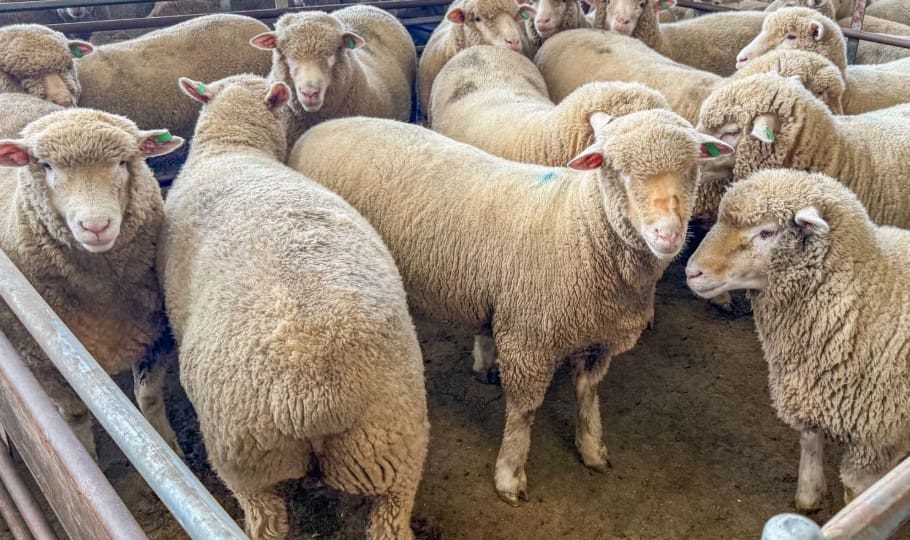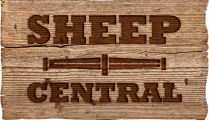
These crossbred lambs were sold by Elders for $350 a head for S. Joice at SELX Yass today. Image – RLX Facebook.
LAMB prices have risen sharply in saleyards nationally after the release of May-August forward contracts at rates of $8.70-$9.80 a kilogram and as yardings steady or start to drop.
Thomas Foods International on Monday released a late May-August delivery contract for 22.11-34kg cwt lambs at its Stawell plant of $9.20-(.80/kg for crossbred lambs, $9-9.60/kg for Dorpers and $9.90-$9.50/kg for merino lambs for lines of more than 50 head.
Similar TFI forward contracts have been released for delivery to TFI’s Lobethal, South Australia, plant and for TFI Tamworth in New South Wales.
TFI national smallstock manager Paul Leonard said the contracts were released to secure sufficient lambs for TFI’s global customers.
Commenting on the prices in the contracts, Mr Leonard said TFI hoped there would be some uplift in the company’s returns going forward.
Despite the industry producing record lamb and goat kills for the past three years, Mr Leonard said the company expected lamb supply to tighten.
Mr Leonard said with the current seasonal difficulties a lot of producers were feeding lambs and TFI wanted to secure some of these to keep its plants running as best it could.
“We’ve got a lot of people employed so you’ve got an obligation to try to keep the wheels ticking over.”
But he said over large areas of large areas of southern New South Wales, Victoria and South Australia, the new season lamb supply perspective was looking “fairly grim.”
He said it was fair to say that lamb and mutton kills nationally as soon as after July would be lower than the levels of the last three years.
Although there has been a big break in northern NSW, he did not expect this would have a big effect on the availability of prime lambs.
Mr Leonard said there had already been good early uptake of the contracts and he believed the contracts would incentivise some producers to take lambs to heavier weights.
At the Bendigo saleyards on Monday, Meat & Livestock Australia’s National Livestock Reporting Service said any good restocking lambs were noticeably dearer, linked into reports of very strong forward price rates being offered for slaughter lambs in July and August.
At this sale the NLRS said prices for heavy ewes jumped $30-$50, with stronger demand on the lead heavy lambs and sheep, and more processors putting pressure on a dominant northern buyer. The reporting service said most lambs gained $5-$15, and often on plainer winter like quality. Heavy export lambs sold from $252-$295 on mixed quality at times. The main run of heavy 26-30kg cwt crossbred lambs sold from $219-$260 and the general run of trade lambs made $175-$220, with select heavy trade lambs in short skins to $236. Good runs of slaughter lambs were estimated as costing processors an average 830-860c/kg cwt, putting the best lambs in each category at near 900c/kg cwt or above. The NLRS said any reasonable quality trade Merino lambs with some fat cover made $170-$210 and some pens were estimated at over 800c/kg. Feeders paid $160-$180 for bigger lambs to feed on. Any decent lines of small restocking lambs made $115-$157.
At Dubbo on Monday, the NLRS said lightweight lambs to the processors were $15 dearer with the 12-18kg 2 score lines selling from $96-$145. Trade lambs were $4-$8 dearer with the 20-24kg lambs making $155-$224/head to average 830-890c/kg cwt. Heavy weight lambs were firm to $4 cheaper with lines over 24kg selling from $213-$275, or 860-895c/kg cwt. The NLRS said Merino lambs were firm with trade weights making $128-$184 and heavy Merino lambs sold to $215. Lambs to the restockers were $20 dearer, with young crossbreds making $75-$168 and young Merino lambs going back to the paddock at $60-$109.
At Forbes in NSW yesterday, the NLRS said extra buyers competed in a dearer market. Light lambs back to the paddock sold from $147-$176. Trade weight lambs were $5-$10 better with 20-24kg lines making $176-$225. Heavy lambs to 26kg sold from $225 to $258. The NLRS said extra heavyweights lifted $10 to $235-$337. Carcase prices ranged from 865-918c/kg.
At Ballarat yesterday, the NLRS said light store and trade lambs sold firm to $5 dearer, medium trade sold $5-$10 better and heavy trades gained $10. Extra heavy export lambs sold to $336, generally up $10-$15 better, although some sales were $25/head dearer, with carcase weight rates reaching 950c/kg cwt. The NLRS said lambs back to the paddock made $38-$161, feed on lines $160-$207. Light trade lambs under 18kg to suit MK orders made $98-$159. The 18-22kg trade lambs sold from $160-$207, 22-26kg lines $193-$225, to average 850-890c/kg cwt. Heavy export lambs 26-30kg made $227-$282 and over 30kg lines sold from $271-$336 to average 890-910c/kg cwt. Merino lambs sold from $45-$172.
At Hamilton in Victoria today, the NLRS said most of the lambs sold $10-$20 dearer with trade lines realizing 880-980c/kg. One pen of extra heavy lambs made $315. Feeder and restocker interest was strong and paid 850-1030c/kg, up to $25/head dearer in places. Light lambs 12-16kg sold from $87-$168 with the 18-22kg lines making $165-$235 and the 22-26kg pens made $200-$266.
At the South Eastern Livestock Exchange at Yass today, the NLRS said light Merino lambs sold $30 stronger with lambs under 16kg selling from $74-$126. The 2 score processing lambs ranged from $150 to $169/head and averaged 800c/kg. Similar weighted lambs to restock sold from $147-$178 lifting around $25/head for the bare shorn lambs. Trade weights were $11-$12 dearer at $175-$214 and averaged 830-860c/kg. Heavy lamb prices lifted $15-$20 to $205-$272, with extra heavy lambs making to $350. Trade Merinos sold from $140-$173 and averaged 680-720c/kg.
Global AgriTrends analyst Simon Quilty commended TFI on its forward contracts and said his models still had trade and heavy lamb prices reaching $10.50/kg in August as strong global demand continued.
“Tight winter supplies are expected that will flow into spring and next year.”
Click here to see TFI’s Lobethal contract.
Click here to see TFI’s Stawell contract.
Click here to see TFI’s Tamworth contract.

HAVE YOUR SAY